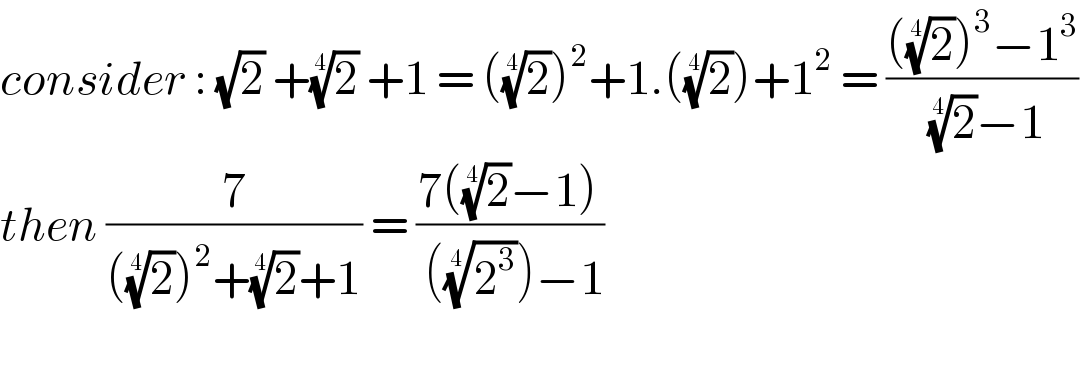
Question Number 113997 by Aina Samuel Temidayo last updated on 16/Sep/20

Answered by bobhans last updated on 16/Sep/20

$${consider}\::\:\sqrt{\mathrm{2}}\:+\sqrt[{\mathrm{4}}]{\mathrm{2}}\:+\mathrm{1}\:=\:\left(\sqrt[{\mathrm{4}}]{\mathrm{2}}\right)^{\mathrm{2}} +\mathrm{1}.\left(\sqrt[{\mathrm{4}}]{\mathrm{2}}\right)+\mathrm{1}^{\mathrm{2}} \:=\:\frac{\left(\sqrt[{\mathrm{4}}]{\mathrm{2}}\right)^{\mathrm{3}} −\mathrm{1}^{\mathrm{3}} }{\:\sqrt[{\mathrm{4}}]{\mathrm{2}}−\mathrm{1}} \\ $$$${then}\:\frac{\mathrm{7}}{\left(\sqrt[{\mathrm{4}}]{\mathrm{2}}\right)^{\mathrm{2}} +\sqrt[{\mathrm{4}}]{\mathrm{2}}+\mathrm{1}}\:=\:\frac{\mathrm{7}\left(\sqrt[{\mathrm{4}}]{\mathrm{2}}−\mathrm{1}\right)}{\:\left(\sqrt[{\mathrm{4}}]{\mathrm{2}^{\mathrm{3}} }\right)−\mathrm{1}} \\ $$$$ \\ $$
Answered by 1549442205PVT last updated on 16/Sep/20

$$\frac{\mathrm{7}}{\mathrm{2}^{\mathrm{1}/\mathrm{2}} +\mathrm{2}^{\mathrm{1}/\mathrm{4}} +\mathrm{1}}=\mathrm{A}+\mathrm{B}.\mathrm{2}^{\mathrm{1}/\mathrm{4}} +\mathrm{C}.\mathrm{2}^{\mathrm{1}/\mathrm{2}} +\mathrm{D}.\mathrm{2}^{\mathrm{3}/\mathrm{4}} \\ $$$$\Leftrightarrow\left(\mathrm{2}^{\mathrm{1}/\mathrm{2}} +\mathrm{2}^{\mathrm{1}/\mathrm{4}} +\mathrm{1}\right)\left(\mathrm{A}+\mathrm{B}.\mathrm{2}^{\mathrm{1}/\mathrm{4}} +\mathrm{C}.\mathrm{2}^{\mathrm{1}/\mathrm{2}} +\mathrm{D}.\mathrm{2}^{\mathrm{3}/\mathrm{4}} \right)=\mathrm{7} \\ $$$$\Leftrightarrow\mathrm{A}.\mathrm{2}^{\mathrm{1}/\mathrm{2}} +\mathrm{A}.\mathrm{2}^{\mathrm{1}/\mathrm{4}} +\mathrm{A}+\mathrm{B}.\mathrm{2}^{\mathrm{3}/\mathrm{4}} +\mathrm{B}.\mathrm{2}^{\mathrm{1}/\mathrm{2}} +\mathrm{B}.\mathrm{2}^{\mathrm{1}/\mathrm{4}} \\ $$$$+\mathrm{2C}+\mathrm{C}.\mathrm{2}^{\mathrm{3}/\mathrm{4}} +\mathrm{C}.\mathrm{2}^{\mathrm{1}/\mathrm{2}} +\mathrm{D}.\mathrm{2}^{\mathrm{5}/\mathrm{4}} +\mathrm{D}.\mathrm{2}+\mathrm{D}.\mathrm{2}^{\mathrm{3}/\mathrm{3}} \\ $$$$=\left(\mathrm{A}+\mathrm{2C}+\mathrm{2D}\right)+\left(\mathrm{A}+\mathrm{B}+\mathrm{C}\right).\mathrm{2}^{\mathrm{1}/\mathrm{2}} \\ $$$$+\left(\mathrm{A}+\mathrm{B}+\mathrm{2D}\right).\mathrm{2}^{\mathrm{1}/\mathrm{4}} +\left(\mathrm{B}+\mathrm{C}+\mathrm{D}\right)^{\mathrm{3}/\mathrm{4}} =\mathrm{7} \\ $$$$\Leftrightarrow\begin{cases}{\mathrm{A}+\mathrm{2C}+\mathrm{2D}=\mathrm{7}\left(\mathrm{sinceD}.\:\mathrm{2}^{\mathrm{5}/\mathrm{4}} =\mathrm{2D}.\mathrm{2}^{\mathrm{1}/\mathrm{4}} \right)}\\{\mathrm{A}+\mathrm{B}+\mathrm{C}=\mathrm{0}}\\{\mathrm{A}+\mathrm{B}+\mathrm{2D}=\mathrm{0}}\\{\mathrm{B}+\mathrm{C}+\mathrm{D}=\mathrm{0}}\end{cases} \\ $$$$\mathrm{Solve}\:\mathrm{above}\:\mathrm{system}\:\mathrm{we}\:\mathrm{get}: \\ $$$$\mathrm{A}=\mathrm{1},\mathrm{B}=−\mathrm{3},\mathrm{C}=\mathrm{2},\mathrm{D}=\mathrm{1} \\ $$$$\mathrm{Hence},\mathrm{there}\:\mathrm{are}\:\mathrm{three}\:\mathrm{true}\:\mathrm{options} \\ $$$$\mathrm{in}\:\mathrm{available}\:\mathrm{answer} \\ $$
